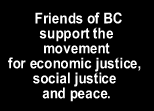
|
|||||||||||||||||||||||
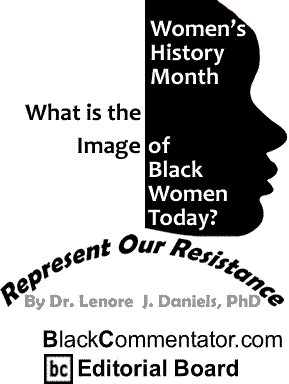 |
|

Custom Search
|
|
|
|
|
 |
|
Last
week, National Public Radio featured a discussion on First Lady
Michelle Obama. The First Lady received her degree from The host and her guest came close: They mentioned in passing, the New Yorker cartoon with the Michelle Obama sporting a natural and carting a rifle, standing next to a turban-wearing Presidential candidate Barack Obama. Close. But the First Lady, the host and her women guest report, has settled into her “role as First Lady” and eased the minds of those who thought she was an “angry Black woman.” She seems to have settled on being the First Lady as Mom, helping her daughters adjust to life in the White House. How original! Mammy in the White House is safe!
Everyone
talks at once! “The role of the First Lady… First Ladies have
done this… First Ladies have done that…” Stop! But this isn’t
about a WHITE First Lady. This is about a Black American woman
as “First Lady” in the White House! This began with the shoulders.
Raise the fear level up for rating and now try to settle the minds
out there in Could
the shoulders at a State of the Those
shoulders walking beside the King, contrary to Euro-American
subjugation of women, is ancient as the Not
long ago, the first Black Congresswoman and first Black major-party
candidate for President of the What a defiant pose? What an unfamiliar pose? Where do I see this image of a Black woman these days? Would such a similar image of a Black woman be published today? Would it be interpreted as the pose of “an angry Black woman,” a “militant” Black woman?
But we are here, today, where on the streets in urban cities, the marketers keep watch. “One
of the most prevalent images of black women in antebellum Today she appears in corporate-produced music videos and films. She appears in corporate produced advertisement. Similar to Barbie for many white Americans, Jezebel is the “given” image to aspire to and to imitate. Jezebel is stylish, modern - “American” with the “exotic” look. Freedom and democracy is the normalization of Jezebel reflected in clothing linked to the culture of capitalism, hair products to straighten the natural texture of hair, and shoes and accessories produced by enslaved labor, all shipped to your local mall “on demand.” The return of the Jezebel signifies not only the employment of a political/cultural strategy to keep Black women’s voices out of the serious discussions today in the world but also a means to deploy a marketable strategy for the use and abuse of the Black family / community through the Black women. How
frightened the rulers in
Demand and supply function in the interests of the capitalists. A people oppressed don’t demand more inferior education for their children or more employment with low wages and no insurance plan. They don’t demand more prisons and tougher sentencing for themselves and their community. What the oppressed do demand is never supplied. Freedom isn’t “given” out to the oppressed. The State’s marketers determine what is “given” out and what is withheld. Self-determination is out of the question. Black women have embraced the look of professional “prostitutes.” I
think of John Henrik Clarke’s story. Dogs meeting in the streets
don’t close doors because they are of a breed that doesn’t give
a damn! Where are we, Black women, today? We’re “strutting our stuff,” shouting, we’ve arrived at the Master’s party. We’re “mainstream” members of American society! The marketers keep watch. Shirley
Chisholm, keenly aware of history and employment of the images
to control and enslave Black woman, maintained that her partnership
was with right, not might! But her tenacity and courage within
the Black community, her resistance within the milieu of Is there a better way to cover up the criminally corrupt and the morally bankrupt system of capitalism? [For a related commentary, read Tolu Olorunda’s, Is the New Old Navy Commercial Racist? In The Daily Voice.]BlackCommentator.com Editorial Board member, Lenore Jean Daniels, PhD,
has been a writer, for over thirty years of commentary, resistance
criticism and cultural theory, and short stories with a Marxist
sensibility to the impact of cultural narrative violence and its
antithesis, resistance narratives. With entrenched dedication
to justice and equality, she has served as a coordinator of student
and community resistance projects that encourage the Black Feminist
idea of an equalitarian community and facilitator of student-teacher
communities behind the walls of academia for the last twenty years.
Dr. Daniels holds a PhD in Modern American Literatures, with a
specialty in Cultural Theory (race, gender, class narratives)
from |
|
Any BlackCommentator.com article may be re-printed so long as it is re-printed in its entirety and full credit given to the author and www.BlackCommentator.com. If the re-print is on the Internet we additionally request a link back to the original piece on our Website. Your comments are always welcome. eMail re-print notice
If you send us an eMail message we may publish all or part of it, unless you tell us it is not for publication. You may also request that we withhold your name. Thank you very much for your readership. |
|
| |
|
| March
26 , 2009 Issue 317 |
|
| Executive Editor: Bill Fletcher, Jr. |
| Managing Editor: Nancy Littlefield |
| Publisher: Peter Gamble |
| Est. April 5, 2002 |
Printer Friendly Version
in resizeable plain
text format or pdf
format. |
| Frequently Asked Questions |
 |
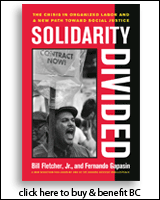
|
 |
 |
 |
| |
| |































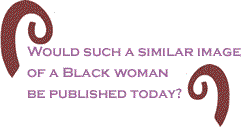 But
wait! Its American radio! The host and her guests remind the audience
that President Barack Obama refers to his wife often! She won’t
be making economic decisions but… He’s said that their marriage
is a partnership… What do you suppose that means… a partnership…?
Michelle doesn’t walk behind Barack; she walks beside him,
even managing speaking engagements apart from him! A partnership?
The First Lady is a Black woman, exposed shoulders and all, an
educated Black American woman who is a partner of
the beloved multi-racial Barack Obama. The beloved savior will
confer with a Black woman! Could there be a “Sapphire”
lurking behind Mammy?
But
wait! Its American radio! The host and her guests remind the audience
that President Barack Obama refers to his wife often! She won’t
be making economic decisions but… He’s said that their marriage
is a partnership… What do you suppose that means… a partnership…?
Michelle doesn’t walk behind Barack; she walks beside him,
even managing speaking engagements apart from him! A partnership?
The First Lady is a Black woman, exposed shoulders and all, an
educated Black American woman who is a partner of
the beloved multi-racial Barack Obama. The beloved savior will
confer with a Black woman! Could there be a “Sapphire”
lurking behind Mammy?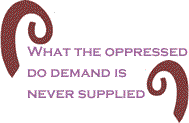 I
was struck by how I had become unfamiliar with the image of a
strong Black woman in which the artist focused on her head,
suggesting a mind bigger than life! Here was, no doubt, an
awake and politically conscious woman. Here was inner strength,
intellect, and yes, a body, appropriately attired so as to not
distract from the fact that she had business and that was
the business of challenging
I
was struck by how I had become unfamiliar with the image of a
strong Black woman in which the artist focused on her head,
suggesting a mind bigger than life! Here was, no doubt, an
awake and politically conscious woman. Here was inner strength,
intellect, and yes, a body, appropriately attired so as to not
distract from the fact that she had business and that was
the business of challenging  The
continued surveillance of Black women reveals a well-nurtured
diffusion of the potential for resistance. No fear, here, of stumbling
upon an “angry Black woman” among drones. Free to flaunt the body
and shake the bootie! Progress! A shoulder is not all the men
will see! But here, more is better! More guarantees the death
of our collective spirit and the impossibility of a united effort
to resist or support strategies of battle against the rulers of
white supremacy.
The
continued surveillance of Black women reveals a well-nurtured
diffusion of the potential for resistance. No fear, here, of stumbling
upon an “angry Black woman” among drones. Free to flaunt the body
and shake the bootie! Progress! A shoulder is not all the men
will see! But here, more is better! More guarantees the death
of our collective spirit and the impossibility of a united effort
to resist or support strategies of battle against the rulers of
white supremacy.

